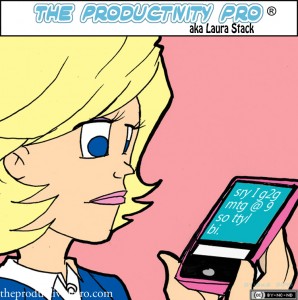“Texting is fingered speech. Now we can write the way we talk.” ― John McWhorter, American linguist and political commentator.
Here is the bi-weekly roundup of activity from Laura Stack’s blog, columns, podcast, and other featured articles. Scroll down to read the complete roundup of productivity resources to help you create Maximum Results in Minimum Time.
Great News!
Great news #1—Amazon.com is having a Cyber Monday sale on my new book, Doing the Right Things Right! If you pre-order the book now, and send your receipt to [email protected], you’ll get all these great pre-order bonuses and free resources!
Great news #2—My publisher is sponsoring a complimentary webinar with Yours Truly on January 13 on Doing the Right Things Right! First 1000 get a seat! Feel free to share with your coworkers and attend together.
This week on the Blog
Texting: It’s Not Just for Fun Anymore

Until recently, cell phone texting wasn’t taken seriously in the business world—and in many cases, it still isn’t. But to the surprise of many, it’s recently begun making serious inroads as a legitimate means of communication, challenging email in popularity. Here’s the thing: there are an estimated five billion cell phone subscribers in the world. While some of those people may have multiple phones, that’s still a staggering number. After all, the world population only recently exceeded seven billion. And here I thought Facebook’s one billion subscribers was impressive!
Not every businessperson has a computer… unless you count the one in his or her hands. Some of those who have no email access have actually begun cutting deals through the SMS messaging feature common to cell phones—a.k.a., texting. This is especially important in developing countries. We sent 9.8 trillion texts in 2012, up 7.8 from 2011, and the numbers have surely risen in the years since. The magazine Fast Company calls texting “the new email,” and it’s carving out its own niche in business, like it or not. This holds especially true in the newly popular BYOD (Bring Your Own Device) workplaces.
But this isn’t your emoji-laden, LOL silliness of the younger generation. Millennials have grown up using SMS text messaging, and they’re quite aware of how to use it professionally. Their preference for it, and its straightforward simplicity, has caused it to spread throughout the business world in a suitably appropriate form. If you’re new to business texting, take heed of the tips that follow.
Business Texting Etiquette
The rules for texting resemble those of any written communication, though the brevity of the messages (no more than 160 characters) has forced some unique exceptions. Abbreviations remain common, though rarely those that those darn kids use. In fact:
- Avoid inappropriate texting abbreviations. LOL and ROTFL may seem appropriate in some cases, but they will forever mark you as an amateur should you use them. Heaven help you if you use LMAO, RTFM, or WTF. Internal company jargon is okay if both parties are very familiar with it.
- Precision counts. The better your grammar and spelling, the easier it is to understand your text. Plus, again, poor spelling and grammar look amateurish.
- Keep an eye on Autocorrect. Sometimes your phone makes guesses about words based on similar things you’ve typed before. As many of us have learned to our chagrin, it sometimes picks the wrong word…occasionally with hilarious or disgusting results. So watch that fat-fingering and re-read!
- Keep texts short, sweet, and to the point. The 160-character maximum naturally poses some limits, but it’s best to organize your thoughts in advance and say what you must in as few words as possible. If you can’t keep it short, email or a phone call are preferable. It’s not meant to have a lengthy conversation but short answers.
- Texting responsibly. Texting a supervisor who prefers emails or phone calls is a bad idea, unless you can’t get a message to them any other way, or they won’t answer your other communication methods.
- Don’t text in meetings. It’s rude, and you may as well yawn in everyone’s face. I’ve seen employees dressed down by their bosses for texting with one client while meeting with another.
- Use texts sparingly. Don’t overwhelm your co-workers with texts. It’s not email. Use them at times when you need their immediate attention—but realize you still may have to wait a while for a response if they’re in a meeting. Texts also offer a good way to let people know there’s an emergency, or you’ve changed a meeting time.
- Beware of who’s watching. If you think someone might read something over your shoulder, don’t text anything proprietary or secret in public.
- Avoid writing in all caps. It makes it look like you’re yelling. Even if you want to yell, control your temper. A tart word may shake loose something you need from someone, but such reactions generally come across as unprofessional.
- Make judicious use of emoticons. Also called “smilies” or “emoji,” emoticons make handy texting shortcuts. But using too many may seem unprofessional to others, especially when the recipient’s phone renders it unreadable. Their occasional use, however, has become widely acceptable when appropriate.
- Never, ever spam. Enough said.
Seeking a Balance
While many businesspeople have embraced texting, some leaders find it an annoying waste of time—just another distraction. Others perceive it as unprofessional, or lacking in cohesion when used in conjunction with email, especially because it doesn’t leave a paper trail. I always long press texts requiring action and forward the string to my email, so I can convert it to a task and work it in to my regular mix.
However, many of us find it useful for quick responses, crisis situations, and alerts, especially when we’re away from our computers and can’t email. Like email, you can also check your message multiple times before you send it, to make sure it’s grammatically correct and makes sense.
When used properly, SMS texting offers a useful communication method that can help you boost your productivity. Just make sure you follow the rules of etiquette outlined above, and remember: it’s not a toy, it’s a tool.
On LinkedIn:
The Workplace Makeover: Revitalizing Your Team From Within
 Who bears the responsibility for team productivity? (<– Click to Tweet) Those with an employee’smindset—for whom work is just a way of getting a paycheck and paying the bills—might point the finger at their leadership. True, the managers and supervisors who direct our work do have a large stake in team productivity. But they don’t bear the responsibility alone. Read More on LinkedIn.
Who bears the responsibility for team productivity? (<– Click to Tweet) Those with an employee’smindset—for whom work is just a way of getting a paycheck and paying the bills—might point the finger at their leadership. True, the managers and supervisors who direct our work do have a large stake in team productivity. But they don’t bear the responsibility alone. Read More on LinkedIn.
In the news:
Achieving Mindfulness In The Workplace at Business 2 Community
Laura Stack’s New Book Will Help Companies to ‘Do the Right Things Right’ at PR Underground
Recommended Articles:
6 Time Management Tips To Make You More Successful
5 ways to be productive as a part-time founder
Podcast
Tune in this week as Laura talks about Eliminating the Major Time-Wasters in Your Day.
© 2015 Laura Stack. Laura Stack, MBA, CSP, CPAE is an award-winning keynote speaker, bestselling author, and noted authority on employee and team productivity. She is the president of The Productivity Pro, Inc., a company dedicated to helping leaders increase workplace performance in high-stress environments. Stack has authored seven books, including her newest work, Doing the Right Things Right: How the Effective Executive Spends Time (Jan. 2016). She is a past president of the National Speakers Association, and in 2015 was inducted into its exclusive Speaker Hall of Fame (with fewer than 175 members worldwide). Stack’s clients include Cisco Systems, Wal-Mart, and Bank of America, and she has been featured on the CBS Early Show and CNN, and in the New York Times. To have Laura Stack speak at your next event, call 303-471-7401 or visit her website.


